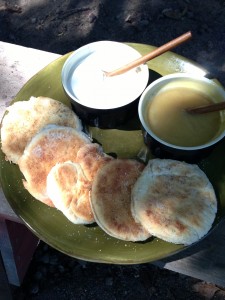Several years ago, I wrote an article for Renaissance Magazine (issue #74 on meatloaf and how recipes could be traced back to ancient Roman cooking. Back then, meatloaf was prepared in sheep stomachs like the Scottish haggis or in upper intestines like sausage and the meatloaf would be baked in a large oven.
Similar recipes have existed for meatballs and have been discovered in German, Belgium, and Holland cooking. In Europe, they use pork, beef, and/or horse meat. In Asian cooking they would use pork, fish or seafood. Unlike meatloaves that had to be shaped and then cooked, meatball recipes were more versatile – could be baked, boiled or fried.
The meatloaf and meatball recipes add various fillers including bread, rice, or oatmeal to chopped, minced or ground meat, and would allow anyone could stretch a small amount of meat to feed others. My mixing the meat and the fillers, cooks could use their hands or spoons to drop the meat in boiling water, hot oil, or bake and choose to serve them immediately, use in another recipe or wrap up to be eaten at a later time. Because of its size, it was very portable and could be used when traveling.
Modern eaters are accustomed to seeing the meatball used in Italian dishes and can be used in other recipes or eaten as a snack. The meatball stew recipe below is simple and is a great people pleaser for the fussiest of palates. It can be adapted for any guest and any ingredient and travels well to potlucks and family dinners.
Meatballs
2 lbs. of ground beef (or turkey)
1 cup of raw oatmeal or breadcrumbs
2 eggs
Mix all of the ingredients together. Form 1.5” – 2” balls and bake for 20 minutes in the oven at 300 degrees. These may be frozen for future use or used in the recipe below.
Meatball Stew
2 lbs of meatballs (Can be pre-prepared or home-made)
4 cups of beef broth (use chicken or turkey broth with ground turkey)
1 cup of baby carrots or regular carrots thickly chopped
One medium onion, coarsely chopped
10 green onions, diced
4 cloves of garlic, minced
1 cup of rice
1 sprig or rosemary
1/2 tsp of thyme
Salt and pepper to taste
Optional: red potatoes, turnips (peeled), green beans, pea pods, or sweet potatoes (peeled)
Serves 3-4
In a cast iron Dutch oven, add the meatballs, broth and add enough water to covered the meatballs. Cook on stovetop or open flame for 20 minutes and add the onions and garlic and let cook for another 20 minutes. Add the carrots and stir occasionally.
If water is getting low, add more water so the meatballs remain covered. Continue cooking for 10 more minutes and add rice, rosemary, and thyme. Stir it up and the rice will settle near bottom to cook. Add optional ingredients. Keep an eye on the pot to make sure the rice doesn’t burn. Cook for 20 – 30 minutes and when rice is done. Garnish with the green onions and serve hot.





